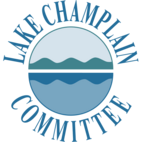LCC August E-News: A Big Party, A Harvest, A Thank You, Water Treatment Woes, Whirling Bugs and More!
Celebrate LCC's 50th on 9/14/13!
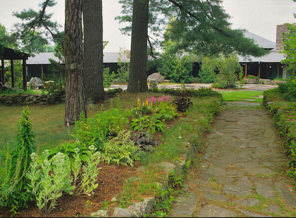
Please join in LCC's 50th birthday party on Saturday, September 14 from 2:00 - 5:00 PM at Flat Rock Camp in Willsboro, New York. We'll reflect on 50 years of lake protection work, honor special volunteers, and look to the future. The afternoon gathering will include delicious refreshments, a brief business meeting, a look back by one of our founding members, a look forward, awards, and ample time for conversation in a beautiful lakeside setting. We'll be serving hors d'oeuvres, wine, beer and other refreshments from local purveyors. Sincere thanks to Peter and Patty Paine and family for hosting the event and to Champlain National Bank for their generous sponsorship. Help us celebrate this special anniversary at a unique Adirondack Great Camp overlooking the lake!
Please RSVP by 9/6/13to be entered into special drawings for door prizes including lake books, bags, a natural history outing with staff scientist Mike Winslow, or a lakeside picnic with executive director Lori Fisher! Register online at www.lakechamplaincommittee.org/register or contact office manager Jessica Rossi at 802-658-1414.
IJC Calls for More Study of Lake Flooding
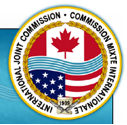
The International Joint Commission (IJC) delivered recommendations to Canada and the United States in late July regarding a Plan of Study for flooding in the Lake Champlain Richelieu River basin. They called for a $14.3 million dollar boondoggle that would rehash issues previously studied in 1937 and 1981.
The recommendations were spurred by the spring flooding of 2011. The United States and Canada asked the IJC to establish a Work Group in March 2012 to draft a plan to study the causes of flooding, analyze flood mitigation solutions, and develop possible structural and non-structural flood mitigation measures on Lake Champlain and the Richelieu River.
“There is no reason to expect that more studies will lead to any different conclusions from those reached in 1981,” said LCC Staff Scientist Mike Winslow. “The key to reducing flood damage is to prevent people from building too close to the water, not in building costly dams or other water regulation tools.” LCC has long been opposed to lake level regulation because of the associated high ecological costs of lost wetlands, duck breeding habitat, and fish spawning grounds. Read more on LCC's website.
Water Treatment Woes
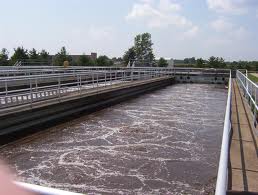
In early August, WCAX reported that a worker error led to discharge of a half-million gallons of untreated sewage to the Winooski River from the Essex Junction wastewater treatment plant. The incident was one of at least thirty cases of sewage overflows in Vermont this year. New York is not immune from such problems either. The Syracuse Post-Standard reported that billions of gallons of untreated sewage enter New York’s waters each year. These incidents provide a stark reminder of the woeful state of water treatment (both waste and drinking) in the region and the country.
The American Society of Civil Engineers recently gave our nation’s drinking water infrastructure a grade of D-. As a consequence of the poor condition, there are 240,000 water main breaks each year in the United States. New York State alone predicts a $38.7 billion price tag for upgrading water supply systems. Vermont’s drinking water infrastructure needs an investment of $395 million over the next twenty years. Read more on LCC's website.
Voices Needed for Lakeshore Protection
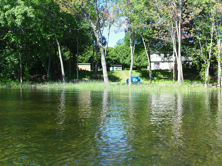
The Vermont Legislature has created a Lake Shoreland Protection Commission to provide information about existing and proposed shoreland protection measures and receive public input on ways to improve regulation of shoreland properties. Vermont is currently the only northeastern state without adequate standards in place to protect natural shoreland and minimize damage from development. The Commission has scheduled a series of public meetings between August and October throughout the state. Times, dates, and locations are noted below and on the Commission's website.
Comparison between developed sites in Maine where shoreland protections are in place and Vermont where there are no statewide standards, indicates that a simple vegetated buffer between homes or camps and the lake provides better fish habitat and cleaner water. Developed and grassed shorelands do not offer these ecosystem benefits. Read more on LCC's website.
LCC Volunteers Help Harvest Invasive Exotic
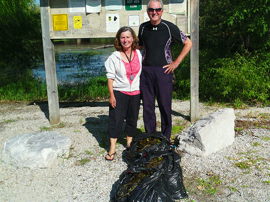
In mid-August, LCC members Joan and Pete Smith joined Staff Scientist Mike Winslow to harvest the invasive European frog-bit from a bay east of Dead Creek on Missisquoi Bay. Together they brought in approximately 900 plants!
The Dead Creek population was first discovered by the Lake Champlain Committee and Arrowwood Environmental in 2011 during a vegetation survey of Missisquoi Bay. LCC and Arrowwood have been working to map the lake’s vegetation to provide a baseline against which any future changes due to climate change, new invasive species, or nutrient loading can be documented. LCC is also trying to remove any new populations of invasives we discover through our survey effort. Two years ago, we removed 77 plants from the site which were mixed among floating aquatic vegetation of a State Significant Water Lily Aquatic Community. A return trip in 2012 netted over 300 plants. Read more about frogbit harvesting on LCC's website.
NASA Interns Track Algae Blooms

A team of student interns working with NASA has developed a model that interprets data collected from satellites to detect and track algae blooms on Lake Champlain. The three young researchers, Tiffani Orne from Liberty University, Hayley Solak from Clark University, and Sam Weber from Virginia Tech, conducted their work from afar, under the guidance of Dr. Kenton Ross. The team consulted with LCC throughout the project. The use of satellite imagery provides information about the entire lake while current monitoring approaches sample individual points around the lake.
The team used sophisticated imaging tools and existing data to create a series of maps showing changes in chlorophyll-a, phycocyanin, cyanobacteria (blue-green algae), and total suspended sediment (TSS) between 2002 and 2013. Chlorophyll-a and phycocyanin are pigments produced by blue-green algae and thus another measure of the algae’s presence. Total suspended sediment is a source of nutrients for the algae and also an indicator of how muddy the water appears. Read more about the NASA interns on LCC's website.
Lake Look: Leeches
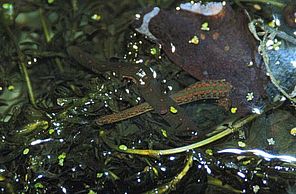
Leeches are related to earthworms. Once you get past the initial revulsion for the animals, you can begin to see a grace and elegance in the orange spotted flattened worms. Both earthworms and leeches are hermaphroditic. Like earthworms they have segmented bodies and lack a structural skeleton. However in earthworms the number of segments varies while leeches all have 34. Where earthworms can add or regenerate body segments, leeches can not. Earthworms have round bodies while most leeches are flattened.
North America hosts perhaps 79 species of leeches with more species in the north than in the south. Worldwide there are 680 species described. The vast majority live in freshwater habitats but about 15% inhabit marine environments, and less than 15% live on land. Some nominally aquatic species will traverse moist ground on occasion. They have been found up to a quarter mile from a waterbody. Leech collectors know to keep their prey well fed because the leeches have a habit of crawling out of aquaria and wandering around the floor. Read more about leeches on LCC's website.
Nature Note – Whirligig Beetles
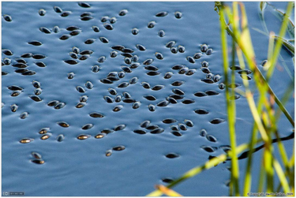
Late summer is the time to see this year’s crop of whirligig beetles, those watermelon seed sized insects that spin and spin on the water surface. The beetles congregate atop tranquil waters around docks or near shore vegetation. The whirligigs that emerge this time of year are newly hatched from eggs laid in the spring. They will overwinter in mud or debris. You can notice two different sizes of the beetles, representing different genera. If you capture and squeeze one of the large ones, they emit a green apple smell, apparently the smaller ones smell worse. The smell is a predator deterrent. In labs, large mouth bass forced to eat whirligigs will spit them out and then re-ingest them in an attempt to dilute the chemical. Whirligigs use their antennae to detect waves on the water’s surface. They then navigate toward the motion hoping to find a struggling insect they can eat. They will also scavenge dead insects from the water surface. You can attract the beetles by repeatedly dipping your finger into the water to create waves. In addition to spinning on the surface, the beetles can dive for prey or fly off to other waters.
Thank You Donors!
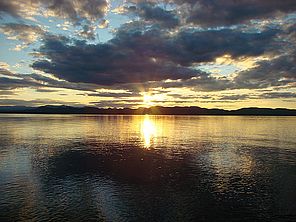
Annual memberships and donations fuel LCC's work for clean, accessible water. By joining LCC and giving each year you help protect and restore water quality, safeguard natural habitats, provide access, and educate and engage people in stewarding Lake Champlain. Our deep thanks to LCC members who renewed their support in recent months. Wondering about your own membership status? Contact us at lcc@lakechamplaincommittee.org and we'll let you know when you last gave.
Moving? Changing Email Addresses?
If you’ve changed your address recently, please send us an email so we can update your files and ensure you receive news on lake issues and LCC’s work. Email is our primary form of communication with members. Mailing electronically saves time and resources and reinforces the stewardship ethic of our mission. We don’t give away or sell email addresses.
To ensure you receive email from LCC, please add lcc@lakechamplaincommittee.org and the domain enews.lakechamplaincommittee.org to your safe/allowed list and address book. Thanks!
Like LCC on Facebook!
Follow LCC on Facebook for beautiful lake photos, informative updates, lake conversations and more!
Lake Champlain Committee Board of Directors
Gary Kjelleren - Chair (South Hero, VT), Sharon Murray - Treasurer (Bolton, VT), Alan Booth (Plattsburgh, NY), Sandy Montgomery (Montreal, QC), Ann Ruzow Holland (Willsboro, NY), Mary Van Vleck (Charlotte, VT), Chuck Woessner (Grand Isle, VT).
Lake Champlain Advisory Council
Megan Epler Wood (Burlington, VT), Steven Kellogg (Essex, NY), Peter S. Paine, Jr. (Willsboro, NY), Mary Watzin (NC).
Lake Champlain Committee Staff
Lori Fisher, Executive Director
Jessica Rossi, Office Manager
Mike Winslow, Staff Scientist
